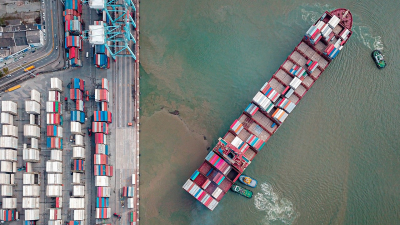Economic growth lagging behind population increase
Recent data from the Organisation for Economic Co-operation and Development (OECD) reveals that Canada is experiencing weaker economic growth compared to its peers. In 2022, Canada’s gross domestic product (GDP) per capita, a key indicator of living standards, fell to 72% of the U.S. GDP per capita. This decline marks a significant shift from two decades ago when Canada was closer to 80% of U.S. levels.
The root of the issue lies in the disparity between economic growth and population growth. In 2022, Canada saw a population increase of nearly 1.3 million people, equivalent to a 3.2% rise, while the economy grew by just 1.1%. As a result, more people are sharing a stagnant economic pie, leading to a collective reduction in wealth. This phenomenon has sparked concerns about Canada's future economic prospects and whether the country can sustain its high standard of living.
Paul Beaudry, a former deputy governor of the Bank of Canada, pointed out that Canada is not only falling behind the U.S. but is also losing ground to other advanced economies. “Relative to other countries, we're getting collectively poorer,” Beaudry said, stressing the urgency of addressing the country's sluggish growth.
Declining gdp per capita: a worrying trend
GDP per capita is a critical measure of a nation's wealth and its citizens' living standards. It represents the total economic output divided by the population, giving a clearer picture of individual prosperity than GDP alone. In recent years, Canada's GDP per capita has consistently fallen, marking five consecutive quarters of decline as of 2023. This prolonged downward trend is alarming, as it suggests that Canadians are becoming relatively poorer compared to citizens of other developed countries.
Trevor Tombe, an economist at the University of Calgary, emphasized the widening gap between Canada and the U.S. “That gap between us and the United States is not just large today. It has been widening at a pace that we haven't seen in generations,” he said. In 2002, Canada’s GDP per capita was 8.6% higher than the OECD average. However, by 2022, it had slipped below this average, signaling a significant loss of economic strength.
Tombe warned that if this trend continues, Canada could face increased emigration to the U.S., particularly among high-skilled workers such as doctors and tech professionals, seeking better economic opportunities. This brain drain could further exacerbate Canada’s economic woes and widen the gap between the two countries.
The u.s. and other global competitors outpacing canada
While the U.S. has long been wealthier than Canada, the economic gap between the two countries has widened in recent years. In the early 2000s, Canada's economic performance was on par with other wealthy nations such as Australia and the United Kingdom. However, by 2022, Canada's GDP per capita had fallen to 91.2% of Australia's, highlighting its relative decline.
This trend extends beyond the U.S. and Australia. Countries like New Zealand and the United Kingdom, despite facing their own economic challenges, have managed to narrow the gap with Canada. As Canada struggles to keep pace with its peers, it risks losing its status as one of the world's most prosperous nations.
The decline in Canada's relative wealth is particularly concerning because it reflects not just slower growth but also deeper structural issues. Economists point to Canada's corporate culture, which has been slow to embrace technological innovation and invest in employee skills, as a key factor contributing to the country's lackluster productivity. Without a competitive business environment, Canada may struggle to achieve the economic dynamism seen in countries like the U.S.
Government responses and potential solutions
Recognizing the severity of the situation, the Canadian government has taken steps to address the country’s declining economic performance. Prime Minister Justin Trudeau has sought the advice of former Bank of Canada governor Mark Carney on strategies to boost economic growth. Treasury Board President Anita Anand has also launched a working group focused on increasing productivity and improving Canada’s economic output.
One of the primary challenges Canada faces is its large influx of immigrants, particularly in the post-COVID period. While immigration has helped sustain population growth, it has also placed pressure on the economy, as many newcomers struggle to integrate into the workforce. The unemployment rate among immigrants stands at nearly 12%, significantly higher than the national average.
Beaudry argues that Canada needs to better manage its immigration policies to ensure that the labor market can absorb the growing number of workers. While reducing the flow of low-skilled workers may offer a short-term boost to GDP per capita, it would not solve the underlying issues plaguing Canada's economy.
Another area of concern is Canada's tax and regulatory environment. Larry Schembri, a senior fellow at the Fraser Institute and a former deputy governor of the Bank of Canada, believes that Canada’s heavy regulatory burden and high tax rates are stifling business investment. He argues that the government should focus more on promoting economic growth rather than redistributing existing wealth. Tax incentives for high-skilled workers and businesses could help reverse the brain drain and encourage domestic investment.
Schembri also highlighted the need to address long-standing interprovincial trade barriers, which have created a fragmented internal market. Despite repeated promises from provincial leaders to reduce red tape, little progress has been made on this front. Overcoming these barriers could boost productivity and unlock new opportunities for economic growth across the country.
Conclusion: reversing canada’s economic decline
Canada’s economic struggles, marked by declining GDP per capita and sluggish productivity, pose a serious threat to its long-term prosperity. As the wealth gap between Canada and its global peers widens, there is growing concern that the country could fall even further behind if decisive action is not taken. The government’s efforts to address these challenges, including seeking expert advice and launching productivity initiatives, are steps in the right direction, but more needs to be done.
Improving Canada’s economic outlook will require a multi-faceted approach, including better management of immigration, increased corporate investment in innovation, and reforms to the tax and regulatory systems. By addressing these structural issues, Canada can regain its competitive edge and ensure a brighter economic future for its citizens.
source: CBC


 Are you thinking about investing in real estate in Albania? Looking for a safe and profitable opportunity? Balfin Real Estate
Are you thinking about investing in real estate in Albania? Looking for a safe and profitable opportunity? Balfin Real Estate The issue of tariffs has gained significant attention in Canada following months of warnings from U.S. President Donald Trump. Tariffs
The issue of tariffs has gained significant attention in Canada following months of warnings from U.S. President Donald Trump. Tariffs The Canadian government has taken decisive action following new U.S. tariffs. Prime Minister Justin Trudeau announced immediate countermeasures after President
The Canadian government has taken decisive action following new U.S. tariffs. Prime Minister Justin Trudeau announced immediate countermeasures after President

